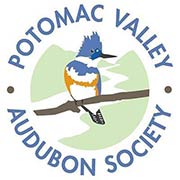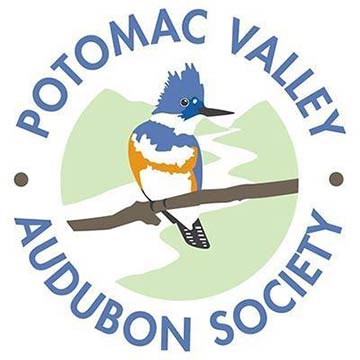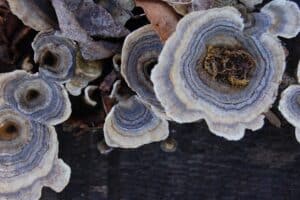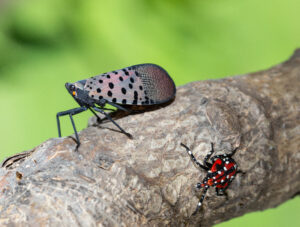
SLF-spotted lanternfly (Lycorma delicatula) winged adult 4th instar nymph (red body) in Pennsylvania, on July 20, 2018. USDA-ARS Photo by Stephen Ausmus.
Eliminating the Spotted Lanternfly from our area may be an impossible feat at this point. However, any efforts to reduce the population of this pesky invasive bug are still worthwhile. Essentially, we are buying time for our native flora and fauna to adapt to the Spotted Lanternfly presence without being decimated from our landscape. Over time, it is projected that birds and other insect-loving native critters will learn to consume Spotted Lanternflies as a regular food source.
So, here at PVAS, we are doing our best to continue the fight against Spotted Lanternfly. We recently had two volunteer workdays led by USDA-APHIS Pest Manager Dana Burton. She taught our awesome volunteers the tools of her trade to kill Spotted Lanternflies, particularly those that have yet to hatch. Nymph and adult Spotted Lanternflies are incredible jumpers and very hard to catch. On the other hand, an egg mass is completely sedentary and can contain 40-50 future Lanterflies.
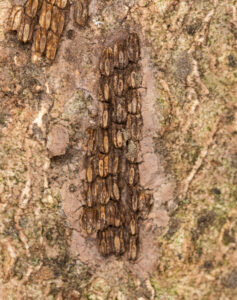
SLF-spotted lanternfly (Lycorma delicatula) Egg mass in Pennsylvania, on July 16, 2018. USDA-ARS Photo by Stephen Ausmus.
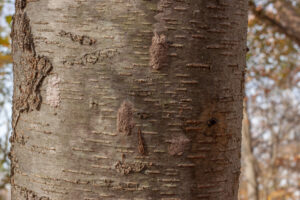
Photo of SLF egg mass by Luke Hearon
There are at least two ecologically friendly methods to eliminate egg masses: scrape them off or spray them with soybean oil. The scrape method results in immediate satisfaction; however, the eggs can pop out, land on the ground, and still hatch. The spray method smoothers all of the eggs within a mass, preventing them from hatching. The trickiest part is learning to spot the egg masses. Eggs are laid on trees (and other wooden objects) and then covered with a grey mud that blends in really well with bark. Although adult Spotted Lanternfly primarily feed on Tree of Heaven, it appears they most frequently lay their eggs on other neighboring trees with rough bark. They also prefer laying on the underside of branches where the eggs are most protected. Armed with soybean oil, our volunteers took to the trails at Cool Spring and Yankauer and killed thousands of Spotted Lanternflies in just a few hours.
Check in your woodlands and or on walks in nature and see if you can spot these egg masses this spring.
*We originally wrote that researchers have found that 90% of these egg masses are laid within the first 12 feet of the tree, meaning that the average person with a sprayer capable of spraying up to 5 feet can get most of the egg masses. Unfortunately, we misunderstood the research, and egg masses can actually be found along the entire length of the tree.
